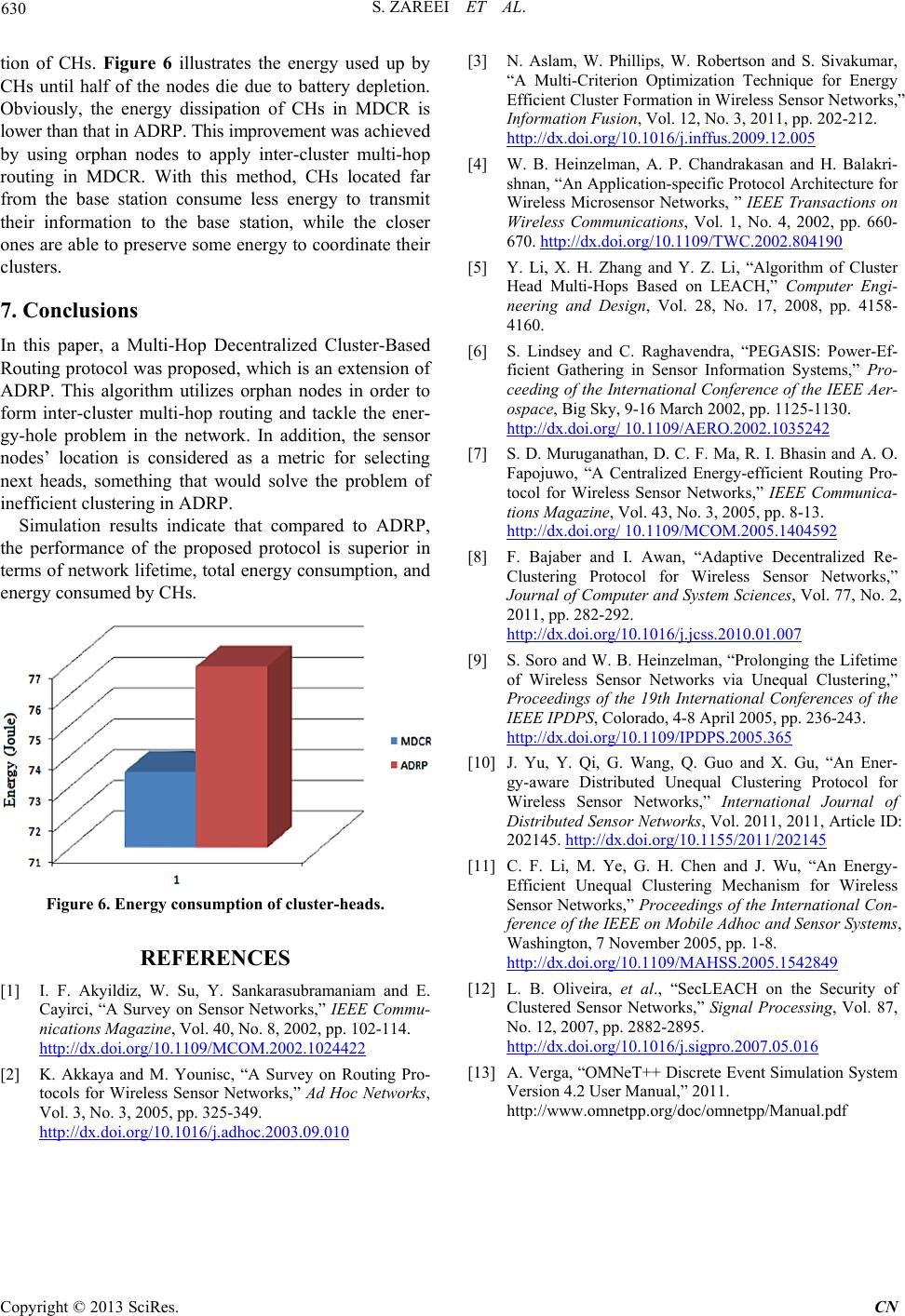
S. ZAREEI ET AL.
Copyright © 2013 SciRes. CN
tion of CHs. Figure 6 illustrates the energy used up by
CHs until half of the nodes die due to battery depletion.
Obviously, the energy dissipation of CHs in MDCR is
lower than that in ADRP. This improvement was achieved
by using orphan nodes to apply inter-cluster multi-hop
routing in MDCR. With this method, CHs located far
from the base station consume less energy to transmit
their information to the base station, while the closer
ones are able to preserve some energy to coordinate their
clusters.
7. Conclusions
In this paper, a Multi-Hop Decentralized Cluster-Based
Routing protocol was proposed, which is an extension of
ADRP. This algorithm utilizes orphan nodes in order to
form inter-cluster multi-hop routing and tackle the ener-
gy-hole problem in the network. In addition, the sensor
nodes’ location is considered as a metric for selecting
next heads, something that would solve the problem of
inefficient clustering in ADRP.
Simulation results indicate that compared to ADRP,
the performance of the proposed protocol is superior in
terms of network lifetime, total energy consumption, and
energy consumed by CHs.
Figure 6. Energy consumption of cluster-heads.
REFERENCES
[1] I. F. Akyildiz, W. Su, Y. Sankarasubramaniam and E.
Cayirci, “A Survey on Sensor Networks,” IEEE Commu-
nications Magazine, Vol. 40, No. 8, 2002, pp. 102-114.
http://dx.doi.org/10.1109/MCOM.2002.1024422
[2] K. Akkaya and M. Younisc, “A Survey on Routing Pro-
tocols for Wireless Sensor Networks,” Ad Hoc Networks,
Vol. 3, No. 3, 2005, pp. 325-349.
http://dx.doi.org/10.1016/j.adhoc.2003.09.010
[3] N. Aslam, W. Phillips, W. Robertson and S. Sivakumar,
“A Multi-Criterion Optimization Technique for Energy
Efficient Cluster Formation in Wireless Sensor Networks,”
Information Fusion, Vol. 12, No. 3, 2011, pp. 202-212.
http://dx.doi.org/10.1016/j.inffus.2009.12.005
[4] W. B. Heinzelman, A. P. Chandrakasan and H. Balakri-
shnan, “An Application-specific Protocol Architecture for
Wireless Microsensor Networks, ” IEEE Transactions on
Wireless Communications, Vol. 1, No. 4, 2002, pp. 660-
670. http://dx.doi.org/10.1109/TWC.2002.804190
[5] Y. Li, X. H. Zhang and Y. Z. Li, “Algorithm of Cluster
Head Multi-Hops Based on LEACH,” Computer Engi-
neering and Design, Vol. 28, No. 17, 2008, pp. 4158-
4160.
[6] S. Lindsey and C. Raghavendra, “PEGASIS: Power-Ef-
ficient Gathering in Sensor Information Systems,” Pro-
ceeding of the International Conference of the IEEE Aer-
ospace, Big Sky, 9-16 March 2002, pp. 1125-1130.
http://dx.doi.org/ 10.1109/AERO.2002.1035242
[7] S. D. Muruganathan, D. C. F. Ma, R. I. Bhasin and A. O.
Fapojuwo, “A Centralized Energy-efficient Routing Pro-
tocol for Wireless Sensor Networks,” IEEE Communica-
tions Magazine, Vol. 43, No. 3, 2005, pp. 8-13.
http://dx.doi.org/ 10.1109/MCOM.2005.1404592
[8] F. Bajaber and I. Awan, “Adaptive Decentralized Re-
Clustering Protocol for Wireless Sensor Networks,”
Journal of Computer and System Sciences, Vol. 77, No. 2,
2011, pp. 282-292.
http://dx.doi.org/10.1016/j.jcss.2010.01.007
[9] S. Soro and W. B. Heinzelman, “Prolonging the Li fetime
of Wireless Sensor Networks via Unequal Clustering,”
Proceedings of the 19th International Conferences of the
IEEE IPDPS, Colorado, 4-8 April 2005, pp. 236-243.
http://dx.doi.org/10.1109/IPDPS.2005.365
[10] J. Yu, Y. Qi, G. Wang, Q. Guo and X. Gu, “An Ener-
gy-aware Distributed Unequal Clustering Protocol for
Wireless Sensor Networks,” International Journal of
Distributed Sensor Networks, Vol. 2011, 2011, Article ID:
202145. http://dx.doi.org/10.1155/2011/202145
[11] C. F. Li, M. Ye, G. H. Chen and J. Wu, “An Energy-
Efficient Unequal Clustering Mechanism for Wireless
Sensor Networks,” Proceedings of the International Con-
ference of the IEEE on Mobile Adhoc and Sensor Systems,
Washington, 7 November 2005, pp. 1-8.
http://dx.doi.org/10.1109/MAHSS.2005.1542849
[12] L. B. Oliveira, et al., “SecLEACH on the Security of
Clustered Sensor Networks,” Signal Processing, Vol. 87,
No. 12, 2007, pp. 2882-2895.
http://dx.doi.org/10.1016/j.sigpro.2007.05.016
[13] A. Verga, “OMNeT++ Discrete Event Simulation System
Version 4.2 User Manual,” 2011.
http://www.omnetpp.org/doc/omnetpp/Manual.pdf